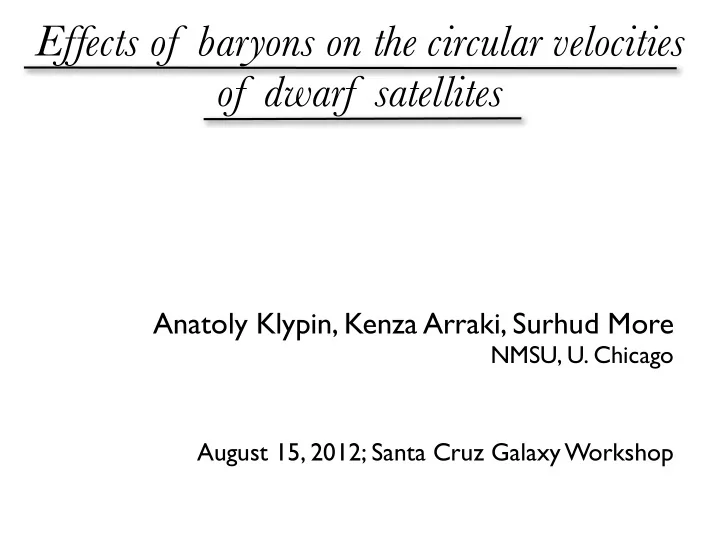

Effects of baryons on the circular velocities of dwarf satellites Anatoly Klypin, Kenza Arraki, Surhud More NMSU, U. Chicago August 15, 2012; Santa Cruz Galaxy Workshop
LCDM and dwarfs: love to hate • Missing satellites • Core/cusp • Too big to fail • Velocity function of (dwarf) galaxies
Missing Satellites Klypin et al./Moore etal. 1999 Diemand et al. 2008 Klypin et al. 1999
Velocity function of galaxies Klypin, Karachentsev, Nasonova, 2012 Local Volume Papastergis et al. 2011 Alfalfa LCDM Observed Trujillo-Gomez et al. 2011
“Massive Failures” - Boylan-Kolchin 2011 & 2012
“Massive Failures” MW observations: • 9 dSphs have 12 km/s < V_max < 30 km/s • 3 dIrr can have V_max >30 km/s Aquarius simulations: • 8 subhalos with V_max > 30 km/s However: Aquarius uses outdated cosmology with with 25% higher amplitude of fluctuations on the scale of dwarf => more satellites each having higher concentration than for WMAP7
Massive Failures: “Solutions” Reduce Mass of MW to 10 12 Msun: Vera-Ciro et al. 2012; Wang et al. 2012 Wang et al. 2012
MW models with 1012Msun are compatible with observations Klypin et al. 2002
“Massive Failures” Solutions - Change CDM Lovell et al. 2012, Vogelsberger et al. 2012 Lovell et al. 2012
Walker & Pennarubia 2011 Fornax Sculptor Gamma =2 => slope= -1
Cusps and cores: if baryons are removed, will cusp flatten? Navarro, Eke, Frenk 96. One episode of instantaneous baryon removal flattens DM cusp M bar =0.2M dm M bar =0.05M dm Numerics: 10k particles, force softening 0.03 => central region is not resolved. Unrealistic size of baryons: too small, too dense
Massive Failures: “Solutions” - Baryons di Cintio et al. 2011 & 2012, Vera-Ciro et al. 2012, Zolotov et al 2012, Brooks &Zolotov 201 2 • adiabatic contraction/expansion • feedback +UV • tidal stripping
Baryons: at effects we naively exct N-body simulations already include baryons: they follow DM feedback+UV: • Stellar mass in real dwarfs is very small. Fornax has 10 7 Msun, Draco has 2.10 5 Msun. • removes most of baryons: expected effect on velocities is √ (Bar_fraction) =>10% in Vcirc: too little to worry about tidal stripping: • already included in N-body
Zolotov et al 2012: Effects of baryons in cosmological Hydro+N-body simulations
Zolotov et al Boylan-Kolchin et al Resolution is a very serious problem even with the best current simulations
In order to resolve stellar feedback in dwarfs, the resolution should be (optimistically) 10-20 pc It cannot be done with 200 pc resolution Tollerud et al
Satellite in grav. potential of Milky Way Very high resolution N-body simulations: 20 pc m 1 =2x 10 4 M sun Neff =1.3x10 6 Testing numerous effects: • baryon removal: slow vis. instantaneous • More realistic Milky Way models • Tidal stripping for various orbits • Time-dependance
Cosmological N-body sims Corrected N-body sims Baryons removed: reduces Vcirc of Baryons are locked up in DM particles satellite Milky Way does not have baryon excess Add disk mass: increases tidal force mass in the central 10 kpc
Satellites: r s =4 kpc v max =63 km/s m vir =3.2x10 10 M sun MW halo: r s =25 kpc v max =180 km/s m vir =1.4x10 12 M sun MW disk: r 0 =3 kpc m vir =6x10 10 M sun Orbits: 50 kpc 100 kpc 150 kpc
Isolated dwarf: effects of removal of 20% of mass Instantaneous or slow removal of baryons produce the same effect Adiabatic expansion is a good approximation: Vcirc declines by 20% and Rmax increases by 20% Effect is much stronger at R<Rs: at 1kpc V circ declines by factor 1.4
Does the baryon removal create a core? no removal No after removal slow removal after removal / no removal fast removal no removal no removal
Tidal stripping of a distressed dwarf: Cumulative effect: - reduce mass by removing baryons and - tidal forces with baryons added to mimic stellar disk of MW
Boylan-Kolchin et al
Aquarius No removal, isolated MW sats
Just stripping isolated 150kpc 100kpc stripping by 50kpc MW halo, no stellar disk
No stripping. Only baryon removal
All included: stripping + MW with stellar disk + baryon removal isolated 150kpc 100kpc 50kpc
From Milky Way to sateite: you come t close, I ki you Time 50 kpc orbit at different moments t=0 1Gyr 2Gyr 3Gyr 4Gyr 5Gyr
Conclusions • Effects of baryons on dSph are strong • Removal of a large fraction of baryons from the central region results in adiabatic expansion of the dwarf • Fast or slow expansion produce the same results • Unless we go through many cycles of infall-expansion- infall-expansion... the cusp is not flattened. It seems that there are not enough stars in dSph to get to Mashchenko-Governato-Pontzen scenario. • Numerically very difficult problem for hydro. Easy to get through N-body • Estimates of annihilation signal may be compromised if they use a large boost factor from substructure.
Recommend
More recommend